Enhanced TDS
Identification & Functionality
- Chemical Family
- RTU Product Type
- Technologies
- Product Families
Features & Benefits
- Ready-to-Use Product Features
- Features and Benefits
- Good mechanical and electrical end properties.
- Very high thermal endurance properties.
- Class H according to IEC 60085.
Applications & Uses
- Application Area
- Compatible Substrates & Surfaces
- Composites Processing Methods
- Cure Method
- System Preparation
Long pot life is desirable in the processing of any casting and impregnating resin system. Mix all of the components together very thoroughly at room temperature or slightly above and under vacuum. Proper mixing will result in homogenous mixture with uniform reactivity.
For the mixing of medium to high viscous casting resin systems and for mixing at lower temperatures, we recommend special thin film degassing mixers. For this low viscous impregnating resin systems, conventional anchor mixers are usually sufficient.
In larger plants, two premixers are used to mix the individual components (resin, hardener) with the respective quantities of additives under vacuum. Metering pumps then feed these premixes to the final mixer or a continuous mixer. The individual premixes can be stored at elevated temperature (about 60°C) for up to about 1 week, depending on formulation.
Note: A premix of accelerator with resin is not stable; a premix of accelerator with hardener is stable under certain conditions. Please contact our staff for details.
Mixing time can vary from 0.5 to 3 hours, depending on mixing temperature, quantity, mixing equipment and the particular application. The required vacuum is 0.5 to 8 mbar. The vapour pressure of the individual components should be taken into account.
- Processing Information
The effective pot-life of the mix is about 1 day at temperatures below 25°C. Conventional batch mixers should be cleaned once a week or at the end of work. For longer interruptions of work, the pipes of the mixing and metering installations have to be cooled and cleaned with the resin component to prevent undesired viscosity increase. Interruptions over a week-end (approx. 48h) without cleaning are possible if the pipes are cooled at temperatures below 18°C. In case to use mixtures with high reactivity, we recommend to clean daily with the flexibilizer DY 040. Viscosity increase and gel time at various temperatures, refer Page 4.
Mold temperature
Conventional vacuum casting 80 - 100°C
Demolding times (depending on mold temperature and casting volume)
Conventional vacuum casting 4 - 8 h with 1 pbw DY 061
10 - 18 h with 0.2 pbw DY 061 or DY 062
Cure conditions (minimal postcure)
Conventional Vacuum Casting4h at 80°C + 10h at 130°C or 4h at 80°C + 6h at 140°C or 12h at 80°C + 10h at 130°C
Castings with big volume (exothermic reaction, internal mechanical stresses) or encapsulations of heat sensitive active parts could be cured at appr. 80°C. To determine whether crosslinking has been carried to completion and the final proper- ties are optimal, it is necessary to carry out relevant measurements on the actual object or to measure the glass transition temperature. Different gelling and cure cycles in the manufacturing process could lead to a different crosslinking and glass transition temperature respectively.
Processing Viscosities
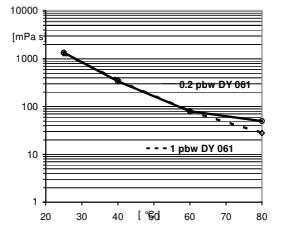
Fig.4.1: Initial viscosity as a function of temperature with DY 061 (0.2 resp. 1 pbw ) (measurements with Rheomat 115, D =10 s⁻¹)
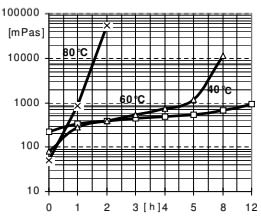
Fig.4.2: Viscosity increase at 40, 60 and 80°C with DY 061, (1 pbw) (measurements with Rheomat 115, D= 10 s⁻¹)
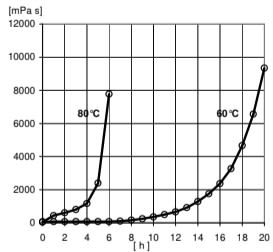
Fig.4.3 Viscosity increase at 60 and 80°C with DY 061 (0.2 pbw) (note: different and low amount of accelerator, especially recommended for transformer casting)
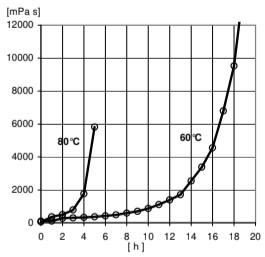
Fig.4.4: Viscosity increase at 60 and 80°C with DY 062 (0.2 pbw) (note: different and low amount of accelerator, especially recommended for transformer casting)
Gelation-/Cure Times
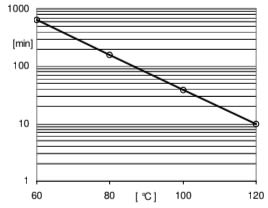
Fig.4.5:Geltime measured as a function of temperature with DY 061, (1 pbw) (measured on Gelnorm Instrument / ISO 9396)
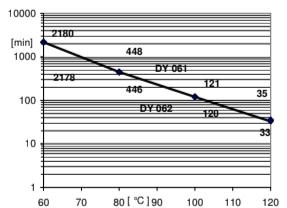
Fig.4.6 Geltime measured as a function of temperature with DY 061 & DY 062 (0.2 pbw) (measured on Gelnorm Instrument / ISO 9396)
Mechanical and Physical Properties
Key Value Unit Test Method Condition Tensile strength 80 - 90 MPa ISO 527 Cured for 12h at 80°C + 10h at 130°C
Elongation at break 4 - 6 % ISO 527 Cured for 12h at 80°C + 10h at 130°C
E modulus from tensile test 3,300 - 3,900 MPa ISO 527 Cured for 12h at 80°C + 10h at 130°C
Flexural strength 140 - 160 MPa ISO 178 Cured for 12h at 80°C + 10h at 130°C
Surface strain 5 - 7 % ISO 178 Cured for 12h at 80°C + 10h at 130°C
Compressive strength 120 - 140 MPa ISO 604 Cured for 12h at 80°C + 10h at 130°C
Impact strength 18 - 25 kJ/m² ISO 179 Cured for 12h at 80°C + 10h at 130°C
Martens temperature 80 - 90 °C DIN 53458 Cured for 12h at 80°C + 10h at 130°C
Glass transition temperature (DSC) 95 - 105 °C ISO 11357-2 Cured for 12h at 80°C + 10h at 130°C
Coefficient of linear thermal expansion 65 - 75 × 10⁻⁶ K⁻¹ ISO 11359-2 Cured for 12h at 80°C + 10h at 130°C
Thermal conductivity 0.2 - 0.3 W/m·K Similar to ISO 8894-1 Cured for 12h at 80°C + 10h at 130°C
Glow resistance 3a DIN 53459 Cured for 12h at 80°C + 10h at 130°C
Thermal endurance profile (TEP) 188 / 203 °C DIN/IEC 60216 Cured for 12h at 80°C + 10h at 130°C
Temperature index (TI): flexural strength (20,000h/10,000h)(1) 200 °C IEC 60085 Cured for 12h at 80°C + 10h at 130°C
Thermal ageing class (20,000h) H IEC 60085 Cured for 12h at 80°C + 10h at 130°C
Water absorption (10 days at 23°C) 0.25 - 0.3 % by wt ISO 62 Cured for 12h at 80°C + 10h at 130°C
Water absorption (60 minutes at 100°C) 0.25 - 0.3 % by wt ISO 62 Cured for 12h at 80°C + 10h at 130°C
Density (Filler load: 66% by wt.) 1.15 - 1.25 g/cm³ ISO 1183 Cured for 12h at 80°C + 10h at 130°C
(1) measured with glass fibre reinforced system CY 5980/HY 5980/DY 073-1, see figure 7.1
Electrical Properties
Key Value Unit Test Method Condition Breakdown strength (IEC 60243-1) 16 - 20 kV/mm IEC 60243-1 Cured for 6h at 80°C + 10h at 130°C
HV arc resistance (IEC 61621) 60 - 110 sec IEC 61621 Cured for 6h at 80°C + 10h at 130°C
Tracking resistance (IEC 60112) > 600 - 0.2 N/A IEC 60112 Cured for 6h at 80°C + 10h at 130°C
Tracking resistance (with test solution B CTI) > 600M - 0.1 N/A IEC 60112 Cured for 6h at 80°C + 10h at 130°C
Electrolytic corrosion (IEC 60426) A-1 Grade IEC 60426 Cured for 6h at 80°C + 10h at 130°C
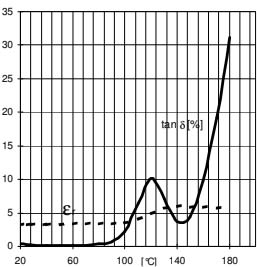
Fig. 6.1 Loss factor (tan δ) and dielectric constant (εr) as a function of temperature (measurement frequency: 50 Hz, IEC 60250)
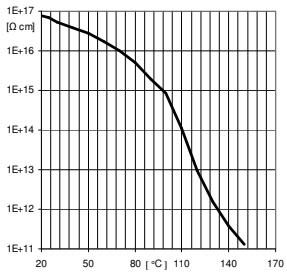
Fig. 6.2 Volume resistivity (ρ) as a function of temperature (measurement voltage: 1000 V, IEC 60093)
Special Properties and Values
Investigated property: Flexural strength (ISO 178)
Selected end point: 50% of initial value (422.9 MPa)
TI (H I C) 193 (13)
Statistical test variables:CH²= 54.48
F= 8.61
Lower 95% confidence curve T C a: 191°C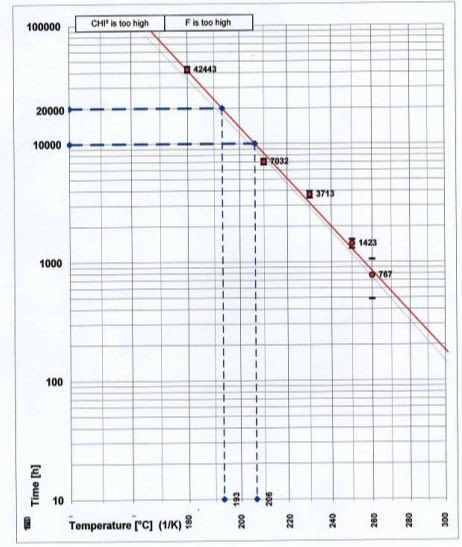
Fig. 7.1 With the high temperature index given above the materials qualify for use in systems with a thermal class of 180°C. This makes it suitable for designing and producing of class H cast resin distribution transformers.
- Application Information
Dry-type distribution transformers, glass fibre reinforced.
Properties
- Physical Form
- Notes
Aradur® HY 5980 is sensitive to humidity and tends to crystallise at low storage temperature. It can be re-liquefied by stirring and heating it to 40 - 80°C.
Regulatory & Compliance
- Certifications & Compliance
Storage & Handling
- Storage Conditions
Store the components in a dry place according to the storage conditions stated on the label in tightly sealed original containers. Under these conditions, the shelf life will correspond to the expiry date stated on the label. After this date, the product may be processed only after reanalysis. Partly emptied containers should be tightly closed immediately after use. For information on waste disposal and hazardous products of decomposition in the event of a fire.
Other
- Application Information
Value Units Test Method / Conditions Mix Ratio 0.002 %(W) %(W) Accelerator : Resin Mix Ratio 0.95 %(W) %(W) Hardener : Resin - Physical Properties
Value Units Test Method / Conditions Glass Transition Temperature (Tg) 100.0 °C °C
